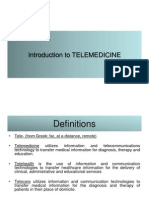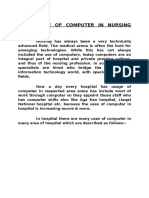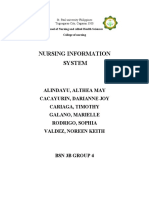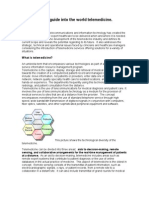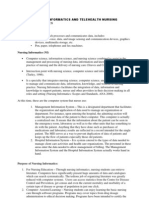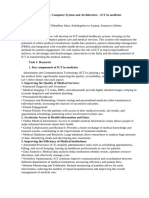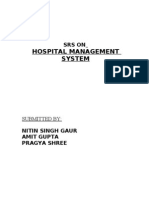Untitled
Untitled
Uploaded by
aysh2383Copyright:
Available Formats
Untitled
Untitled
Uploaded by
aysh2383Copyright
Available Formats
Share this document
Did you find this document useful?
Is this content inappropriate?
Copyright:
Available Formats
Untitled
Untitled
Uploaded by
aysh2383Copyright:
Available Formats
ROLE OF IT IN HEALTHCARE Information technology (IT) holds the key to a radical transformation of the hea lthcare industry.
The next revolution in healthcare is not only about medicine, but about using technology to deliver information that drives safe and efficient patient-centric care. Advanced technology solutions are giving rise to futuristic digital hospitals wher e everything is connected. IT can provide hospitals with infrastructure solutions that deliver the agility and adaptability required to support the changing nature of Health Information T echnology. DIGITAL HOSPITAL By definition, the digital hospital is connected which leads to better efficienc y and information flow laying the groundwork for better patient care. In a digital hospital, systems and people communicate real time information, im proving responsiveness, accuracy and ultimately patient care. A digital hospital can extend services beyond its physical boundaries creating a better healthcare experience for the community FAST FACTS Digitally advanced hospitals experience greater reductions in the average length of patient stay and larger increases in operating revenues. Digital hospitals spend merely three and five percent of their operating budget on IT. FEATURES Tele-health Electronic Health Records (EHR & Interoperability) Security, Privacy, and the Law for the Healthcare Industry Hospital Design and IT Track and Trace E-Prescribing WHAT IT ENTAILS Replacing expensive, hard-to-share and easily lost films (e.g. X-rays) with digi tal images that can be effortlessly shared, stored and accessed. Moving from an environment dominated by hand-written notes and physician orders to an environment in which staff use information systems to document patient rec ords as well as enter and process orders. Taking advantage of advanced technology such as RFID and using it imaginatively to meet a host of needs, such as 1. prescribing and checking drug interactions at the point of care 2. quickly checking a patients blood type during an operation 3. matching newborn infants with their parents, or 4. triggering a lock-down if an infant is removed from a secured area. FOR DOCTORS Enables them to visit their patients in the hospital from wherever they are in t he world. Allow doctors to communicate with other hospital staff members from outside the hospital. They can view patients X-rays by logging into a radiology program through intra net. The images are crisper than they are on film, and the system saves doctors from having to run to the hospital s radiology department to look at test result s. Allows doctors to order new tests and meds via computer right from a patient s b edside. Since there are no handwritten prescriptions, there are also no more worries abo ut illegible orders by physicians. (By reducing errors, the technology reduces t
he costs associated with medical mistakes.) NURSES Nurses can use a wireless laptop to enter information about patients right at th e bedside by logging in wirelessly to the hospital s central patient-charting sy stem 1. patients vital signs 2. symptoms, and 3. medications. FOR PATIENTS Built-in videoconferencing technology allows patients to converse with their phy sicians through the robot, making them feel as if the doctors are right in the r oom. SYSTEM SECURITY The systems security features prevent third parties from accessing private patien t information. At the same time, it helps to minimize faxes, phone calls and the like while pro viding patients the information they need to participate more fully in their hea lthcare experience. The new technology allows hospitals to match medication with patients more quick ly, easily and accurately. Computers scan a bar code on a patient s wristband, then scan the bar code on th e medication and indicate if it is safe to administer the drugs. ADVANTAGES Hospital resources employed more efficiently Internal processes optimized Quality and safety of care improved through real-time reliable communication Patient information shared quickly and with a high degree of security Mobile equipment and key assets can be tracked wirelessly Patients can be monitored remotely, quickly and accurately; By combining EMR with wireless mobile technology, patient records follow you whe rever you go. Patient files can be retrieved where and when needed by Doctors. Ability to be in two places at once can make a major difference in productivity an d in quality of patient care. ULTIMATELY Better access to information, less duplication of effort and shorter patient sta ys Reduce information bottlenecks and enable ongoing development of workflows More time spent on patient care and less time on paperwork More satisfied employees and patients Making diagnosis and treatment faster and more efficient;
You might also like
- TelemedicineDocument26 pagesTelemedicineShane Bridges78% (9)
- Jesse Attachment ReportDocument18 pagesJesse Attachment ReportNicole100% (4)
- How To Survive Hospital StayDocument38 pagesHow To Survive Hospital StayLaurentiu M.No ratings yet
- Importance of Computer in Nursing ProfessionDocument2 pagesImportance of Computer in Nursing ProfessionMuhammad Shahid50% (4)
- MDR EUDAMED-UDI - Data Dictionary V5.0Document226 pagesMDR EUDAMED-UDI - Data Dictionary V5.0aysh23830% (1)
- Comprehensive ExaminationpsyDocument14 pagesComprehensive Examinationpsylori_ii100% (1)
- Mis2 015, SristiDocument5 pagesMis2 015, SristiSrishti PandeyNo ratings yet
- Biomedical Poster TAHDocument1 pageBiomedical Poster TAHJOEM18No ratings yet
- E Health PDFDocument17 pagesE Health PDFSanatan PandaNo ratings yet
- Information Technologies in Health CareDocument5 pagesInformation Technologies in Health Careprabha krishnanNo ratings yet
- Technology (Computer) and Nursing WorkDocument6 pagesTechnology (Computer) and Nursing WorkEfjayNo ratings yet
- Nursing InformaticsDocument46 pagesNursing InformaticsRENJULALNo ratings yet
- Group 4 Nursing InformaticsDocument5 pagesGroup 4 Nursing InformaticsMj GalanoNo ratings yet
- Digital HealthcareDocument10 pagesDigital Healthcaremarishaanidas21No ratings yet
- SMART HOSPITAL DESIGNDocument4 pagesSMART HOSPITAL DESIGNsonu.sood6272No ratings yet
- NCM110 Applications of Nursing Informatics BSN3Document52 pagesNCM110 Applications of Nursing Informatics BSN3bryanmaranan173No ratings yet
- Wi FiDocument9 pagesWi Fialdrinjerry22No ratings yet
- Role of Information Technology in MedicineDocument7 pagesRole of Information Technology in MedicineFahadghaznavi100% (1)
- Unit 1 - Telehealth Technology Anna UniversityDocument30 pagesUnit 1 - Telehealth Technology Anna UniversitySuraj PradeepkumarNo ratings yet
- OMD553-Telehealth Technology: (Open Elective-I)Document15 pagesOMD553-Telehealth Technology: (Open Elective-I)Merlin100% (1)
- Information Technology in Health CareDocument6 pagesInformation Technology in Health CareMohit Jain100% (2)
- Telecommunication (Tele-Health & Tele-Medicine) : Prof. DR / Abeer ZakariaDocument26 pagesTelecommunication (Tele-Health & Tele-Medicine) : Prof. DR / Abeer ZakariaLinda StewartNo ratings yet
- Tablanza-Finals Activity 1 (Lab)Document3 pagesTablanza-Finals Activity 1 (Lab)trust nobodyNo ratings yet
- Institute of Technology, Ulhasnagar. TelemedicineDocument8 pagesInstitute of Technology, Ulhasnagar. TelemedicineLeena LalwaniNo ratings yet
- TELEMEDICINE, EMR, Role of IT in HMDocument27 pagesTELEMEDICINE, EMR, Role of IT in HMHarish Morwani100% (3)
- Teleconferencing, Also Known As Videoconferencing, Allows For Visual and Auditory CommunicationDocument2 pagesTeleconferencing, Also Known As Videoconferencing, Allows For Visual and Auditory CommunicationMara Jon Ocden CasibenNo ratings yet
- Information Technology in Health CareDocument6 pagesInformation Technology in Health CareSpanwz SpanwziNo ratings yet
- Process of Admission, Discharge, Transfer With Utilization of TechnologyDocument7 pagesProcess of Admission, Discharge, Transfer With Utilization of TechnologyCarlo A. OropesaNo ratings yet
- TelemedicineDocument11 pagesTelemedicineSakshi AsthanaNo ratings yet
- A Quick Guide Into The World TelemedicineDocument6 pagesA Quick Guide Into The World TelemedicineMahmoud KhaledNo ratings yet
- Science and TechnologyDocument7 pagesScience and TechnologyHimanshi VohraNo ratings yet
- Computer & MedicineDocument16 pagesComputer & Medicinekmshahd3No ratings yet
- Long Bond PaperDocument11 pagesLong Bond PaperEllehcim Zaracla ZuprocNo ratings yet
- Telemedicine For Healthcare CapabilitiesDocument12 pagesTelemedicine For Healthcare CapabilitiesSandiNo ratings yet
- Framework 2nd Lecture of E HealthDocument7 pagesFramework 2nd Lecture of E Healthmalakmohamed55677No ratings yet
- Computers in Medical FieldDocument14 pagesComputers in Medical Fieldsharul11No ratings yet
- Final Nursing InformaticsDocument6 pagesFinal Nursing InformaticsJhey-ar Toledo100% (1)
- Assignment 1Document9 pagesAssignment 1qasholiqNo ratings yet
- Application of Health InformaticsDocument17 pagesApplication of Health InformaticsTan, kxeeNo ratings yet
- The Impact of Digital Technology On HealthcareDocument2 pagesThe Impact of Digital Technology On HealthcareArthur LemosNo ratings yet
- Assignment Title: Student's NameDocument11 pagesAssignment Title: Student's NameGaurav SharmaNo ratings yet
- ISM - AssignmentDocument8 pagesISM - AssignmentAkshatNo ratings yet
- Key Concepts in Nursing InformaticsDocument9 pagesKey Concepts in Nursing Informaticsluchi darkNo ratings yet
- Uses of ComputerDocument5 pagesUses of ComputerZainab batool BatoolNo ratings yet
- Community Health Information Tracking System (CHITS)Document24 pagesCommunity Health Information Tracking System (CHITS)juanamay30gmailcomNo ratings yet
- Jeppiaar SRR Engineering College: Title: Smart Wearble Health Monitoring For Patient/Elder PeopleDocument12 pagesJeppiaar SRR Engineering College: Title: Smart Wearble Health Monitoring For Patient/Elder PeopleKurushNishanthNo ratings yet
- International Journal of Engineering Research and Development (IJERD)Document3 pagesInternational Journal of Engineering Research and Development (IJERD)IJERDNo ratings yet
- WSN Home HealthcareDocument4 pagesWSN Home Healthcarekichan992No ratings yet
- Ogoy, Princess o (Lab Activity 9)Document8 pagesOgoy, Princess o (Lab Activity 9)PRINCESS OGOYNo ratings yet
- Health Systems and Technology: Course Number: CIS 1200 Dowling CollegeDocument11 pagesHealth Systems and Technology: Course Number: CIS 1200 Dowling CollegecleodeesNo ratings yet
- Rohini 35741355512Document4 pagesRohini 35741355512ghoshproma01No ratings yet
- Told of It in MedicalDocument78 pagesTold of It in MedicalummesiddiquafarooquiNo ratings yet
- Types of TelemedicineDocument9 pagesTypes of TelemedicineMerlinNo ratings yet
- Application of Information Technology in Nursing: Presented by - Ms. Ashwini Rai GNM 1 Year SpionDocument9 pagesApplication of Information Technology in Nursing: Presented by - Ms. Ashwini Rai GNM 1 Year SpionPratika ChettriNo ratings yet
- ComputerDocument14 pagesComputerchandan.surya96No ratings yet
- TelemedicineDocument39 pagesTelemedicineDeepti100% (1)
- The Healthcare (HC) Industry Has Evolved Tremendously Since Its InceptionDocument2 pagesThe Healthcare (HC) Industry Has Evolved Tremendously Since Its InceptionAnjali AravindNo ratings yet
- 5g Use Case in Health CareDocument25 pages5g Use Case in Health CaremashsolosofficialNo ratings yet
- Chiraz::: First Name: Family Name YearDocument4 pagesChiraz::: First Name: Family Name YearchirazNo ratings yet
- 34274-X Benefits of Implementing Advanced Tech in Healthcare FacilitiesDocument12 pages34274-X Benefits of Implementing Advanced Tech in Healthcare Facilitiesnosheena.zeeshanNo ratings yet
- Tizon, R - Assignment#3ncm112Document3 pagesTizon, R - Assignment#3ncm112Royce Vincent TizonNo ratings yet
- Overview of HISDocument12 pagesOverview of HISShwetnisha BoseNo ratings yet
- Nursing Information SystemDocument20 pagesNursing Information SystemShahad Hakimuddin100% (1)
- A Simplified Nursing Informatics.: A Modern Age Health Technology for Nurses and MidwivesFrom EverandA Simplified Nursing Informatics.: A Modern Age Health Technology for Nurses and MidwivesNo ratings yet
- Innovative Solution For Biomedical Waste ManagementDocument5 pagesInnovative Solution For Biomedical Waste Managementaysh2383No ratings yet
- Advanced Biomedical Waste Treatment Solutions: TesalysDocument8 pagesAdvanced Biomedical Waste Treatment Solutions: Tesalysaysh2383No ratings yet
- Sintion Data - 123Document16 pagesSintion Data - 123aysh2383No ratings yet
- Imdrf Tech 190321 Nivd Dma Toc n9 PDFDocument53 pagesImdrf Tech 190321 Nivd Dma Toc n9 PDFaysh2383No ratings yet
- Imdrf Tech 190321 Nivd Dma Toc n9 PDFDocument53 pagesImdrf Tech 190321 Nivd Dma Toc n9 PDFaysh2383No ratings yet
- SNOMED International Global Patient Set (GPS) Package Release Notes - July 2019Document7 pagesSNOMED International Global Patient Set (GPS) Package Release Notes - July 2019aysh2383No ratings yet
- Final Document:: IMDRF Terms of Reference: IMDRF Management Committee: 27 July 2018Document8 pagesFinal Document:: IMDRF Terms of Reference: IMDRF Management Committee: 27 July 2018aysh2383No ratings yet
- Imdrf Proc 151002 Strategic Plan 2020Document5 pagesImdrf Proc 151002 Strategic Plan 2020aysh2383No ratings yet
- Global Medical Device Nomenclature: The Concept For Reducing Device-Related Medical ErrorsDocument7 pagesGlobal Medical Device Nomenclature: The Concept For Reducing Device-Related Medical Errorsaysh2383No ratings yet
- 5.b) Applicant Certification Bodies For ICMED SchemeDocument1 page5.b) Applicant Certification Bodies For ICMED Schemeaysh2383No ratings yet
- 5.a) Approved Certification Bodies For ICMED SchemeDocument4 pages5.a) Approved Certification Bodies For ICMED Schemeaysh2383No ratings yet
- List of Trained ConsultantsDocument1 pageList of Trained Consultantsaysh2383No ratings yet
- 4.b) QCI AIMED Provisional Approval of CBDocument7 pages4.b) QCI AIMED Provisional Approval of CBaysh2383No ratings yet
- 4.a) ICMED Application Form For CBsDocument5 pages4.a) ICMED Application Form For CBsaysh2383No ratings yet
- Guntur Coffee Table BookDocument120 pagesGuntur Coffee Table BookMULLAPUDI0% (1)
- Participle Clauses-A Brief SummaryDocument2 pagesParticiple Clauses-A Brief SummarychoppersureNo ratings yet
- SURPASS 3-Páginas-EliminadasDocument3 pagesSURPASS 3-Páginas-EliminadasJung Ho SeokNo ratings yet
- Accomplishment ReportDocument1 pageAccomplishment ReportChe Valenzuela100% (1)
- 06.05 Sop BillingDocument2 pages06.05 Sop BillingUnathi MbamboNo ratings yet
- Admission and DischargeDocument61 pagesAdmission and DischargeRafia Khalil100% (2)
- Editorial Board - 2018 - Journal of Surgical ResearchDocument2 pagesEditorial Board - 2018 - Journal of Surgical ResearchPatrick PolitoNo ratings yet
- Audit-Report NHS CampaignDocument23 pagesAudit-Report NHS CampaignOvie PangindoNo ratings yet
- Accomplishment ReportDocument1 pageAccomplishment ReportKEANU GYBS PERALTANo ratings yet
- 2016 Style Guide - Carolina For The KidsDocument11 pages2016 Style Guide - Carolina For The KidsCarolina For The Kids FoundationNo ratings yet
- Vilas County News-Review, July 20, 2011Document30 pagesVilas County News-Review, July 20, 2011News-ReviewNo ratings yet
- N Acetylcysteine SNDocument2 pagesN Acetylcysteine SNYuliatyRettaHutahaeanNo ratings yet
- Hospital DesignDocument2 pagesHospital DesignVipulParashar0% (1)
- Pros and Cons of Continuing Nursing EducationDocument14 pagesPros and Cons of Continuing Nursing EducationstanleyNo ratings yet
- Communication:: Good Communication Helps Patients/clients Feel at EaseDocument4 pagesCommunication:: Good Communication Helps Patients/clients Feel at EasemonishaNo ratings yet
- Amplifying The Impact: Examining The Intersection of Mobile Health and Mobile FinanceDocument18 pagesAmplifying The Impact: Examining The Intersection of Mobile Health and Mobile FinancekimwhitNo ratings yet
- DR - Mehta ExternshipsDocument5 pagesDR - Mehta ExternshipsAbdul Kalam SheriffNo ratings yet
- EHS&S Equipment Checkout List: Camp ClinicDocument4 pagesEHS&S Equipment Checkout List: Camp ClinicVictoria GomezNo ratings yet
- Connections Fall 2011Document44 pagesConnections Fall 2011bodyworxsNo ratings yet
- Preeclampsia Care MapDocument3 pagesPreeclampsia Care Mapapi-38011595475% (4)
- A New Simple Technique For Making Facial DimplesDocument4 pagesA New Simple Technique For Making Facial DimplesdoctorbanNo ratings yet
- SRS (Hospital Mgmt. System)Document20 pagesSRS (Hospital Mgmt. System)nitin_gaur_50% (1)
- The Hound of The BaskervillesDocument110 pagesThe Hound of The BaskervillesEleftherios GoulielmakisNo ratings yet
- Us Guided Injection of JointsDocument10 pagesUs Guided Injection of JointsDiana MoldovanNo ratings yet
- Paradigm Shifting in Postgraduate Nursing Education in EthiopiaDocument2 pagesParadigm Shifting in Postgraduate Nursing Education in EthiopiaRose Mmusi-PhetoeNo ratings yet
- COVID-19 - The Nursing Home DiseaseDocument13 pagesCOVID-19 - The Nursing Home DiseaseJon DeckerNo ratings yet
- RFID in Healthcare A Six Sigma DMAIC and Simulation Case StudyDocument31 pagesRFID in Healthcare A Six Sigma DMAIC and Simulation Case StudydrustagiNo ratings yet
